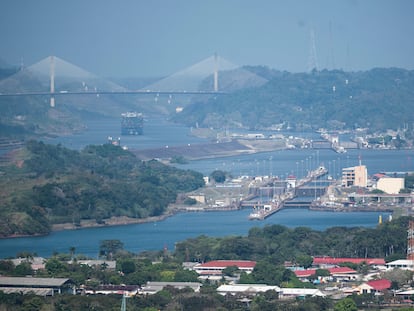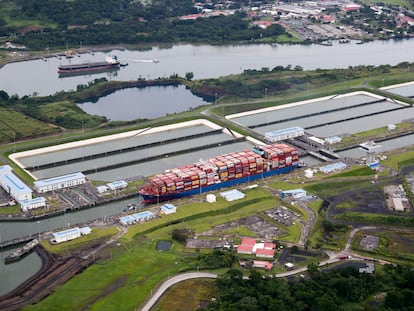The Panama Canal suffers a water crisis putting world trade in jeopardy
The organization that manages this critical artery of global trade estimates losses of over $700 million this year. The chronic drought caused by El Niño has limited the number of ships that can transit each day
It was expected to be a temporary headache, but it is turning into a chronic migraine. The Panama Canal Authority is responsible for the traffic of products valued at $270 billion per year through the Central American shortcut, and this year it has been left high and dry by a historic water crisis. The solution has been to limit the number of ships that make the crossing each day, but that comes with a cost. According to various Panamanian media, the Canal Authority has predicted that income losses in 2024 will be between $500 million and $700 million. Meanwhile, the projections are for water levels to continue to decline.
The problem is measured in feet. Gatún Lake is a man-made body of water in Panama that feeds the Canal, and it has gone from having a water level of 88.8 feet above sea level in late 2022 to just 81.5 currently. This is insufficient for the Canal’s usual capacity of 38 ships per day. The Canal Authority is allowing only 20 vessels to pass through per day and could lower the maximum to 18 in the coming weeks. And the projections for the water level in Gatún Lake suggest that it will drop even further in March.
The restrictions have caused bottlenecks, delays, increased shipping costs, and uncertainty about the future of the Canal, which this year marks 110 years since it was opened. “We are at the mercy of Mother Nature,” says Lori Ann LaRocco, author of the book Trade War: Containers Don’t Lie, Navigating the Bluster. “Every day without sufficient rain just shows how serious the situation is going forward. The only way this will change is if it rains enough. And that, for now, is not happening,” adds LaRocco, also a journalist specializing in supply chains on the American television network CNBC.
In a study published in Nature on January 11, a group of scientists warned that the planet will experience more extreme drought conditions like the one Panama is experiencing as a consequence of the El Niño phenomenon — a climatic event that is related to the warming of the Pacific Ocean — or periods of extreme rain. In a conservative scenario, these patterns are expected to impact approximately three billion people on the planet. But in a more fatalistic scenario, it could be up to five billion people (66% of the world’s population) by the end of the century.
The inflationary impact of the situation in Panama has already been felt by the consumer since the middle of last year. 40% of the container traffic of goods destined for the United States crosses through the Canal, which is used as an alternative to the network of roads and railway lines that connect the country’s Eastern and Western Seaboards, so the final price of the goods has increased.
Transporting each container costs shipping companies about $8,000, according to LaRocco, and each delay puts an additional pressure on the price of goods. Companies are already looking for alternatives. “We have not yet seen a tsunami of containers leaving the port of New York bound for Los Angeles, we are not there yet. But the longer it takes to solve [the Canal’s water crisis], the more this effect will begin to be seen,” the expert warns.
Despite the investment that was made a few years ago, which cost close to $5 billion, that expanded the Canal to allow larger ships to enter, it has been the climate element that has surprised the authorities. “Real and viable alternatives are the optimization of the train and highway system within the United States, as well as the construction of the Interoceanic Corridor in the Isthmus of Tehuantepec in Mexico,” says Roberto Durán, professor and researcher at the School of Governance and Public Transformation at the Monterrey Institute of Technology and Higher Education (TEC) in Mexico.
Climate change
In addition, climate change is opening a new route. Melting ice caused by global warming in northern Canada is creating a new natural waterway that could connect Asia with Europe, passing through North America. “As global trade grows, it increases demand for capacity. And if the Panama Canal is limited in its capacity, we have a problem there,” says Durán.
As if world trade did not already have numerous choke points, one more has just been added. The military response by the United States and the United Kingdom against targets linked to Houthi militias in Yemen has expanded the conflict in the Middle East. In retaliation, the Houthis have been attacking commercial ships transiting through the Red Sea, which is connected to the Mediterranean through the Suez Canal. This is another conduit through which there is heavy shipping traffic as part of global trade.
“Many ocean carriers had begun to opt for the Suez Canal to reach the United States’ eastern coast and avoid any type of delay or fee related to the Panama crossing,” explains LaRocco. “Now that we have the attack on the Red Sea, and that is causing delays and additional costs there.”
This is generating “the famous triple crisis,” says Durán. “We had the health problem that caused a pandemic and the reason why the borders were closed; the geopolitical problem in which suddenly people who you thought were no longer fighting started fighting and, as a consequence, are closing routes; and then there is the climate problem,” the academic explains. For now, the only thing left for the Panamanian government is to look at the sky and pray for rain before the goose that lays the golden eggs dies of thirst.
Sign up for our weekly newsletter to get more English-language news coverage from EL PAÍS USA Edition
Tu suscripción se está usando en otro dispositivo
¿Quieres añadir otro usuario a tu suscripción?
Si continúas leyendo en este dispositivo, no se podrá leer en el otro.
FlechaTu suscripción se está usando en otro dispositivo y solo puedes acceder a EL PAÍS desde un dispositivo a la vez.
Si quieres compartir tu cuenta, cambia tu suscripción a la modalidad Premium, así podrás añadir otro usuario. Cada uno accederá con su propia cuenta de email, lo que os permitirá personalizar vuestra experiencia en EL PAÍS.
¿Tienes una suscripción de empresa? Accede aquí para contratar más cuentas.
En el caso de no saber quién está usando tu cuenta, te recomendamos cambiar tu contraseña aquí.
Si decides continuar compartiendo tu cuenta, este mensaje se mostrará en tu dispositivo y en el de la otra persona que está usando tu cuenta de forma indefinida, afectando a tu experiencia de lectura. Puedes consultar aquí los términos y condiciones de la suscripción digital.
More information
Archived In
Últimas noticias
Maduro pleads not guilty before the federal court in New York: ‘I am still the president of Venezuela’
A new test can detect Alzheimer’s from a finger prick
UN team enters Sudanese city of El Fasher after paramilitary massacre: ‘It’s like a ghost town’
A recipe for resistance: Indigenous peoples politicize their struggles from the kitchen
Most viewed
- Gilles Lipovetsky: ‘If you want to live better and fall in love, take Prozac, don’t look to philosophy’
- Alain Aspect, Nobel laureate in physics: ‘Einstein was so smart that he would have had to recognize quantum entanglement’
- Alvin Hellerstein, a 92-year-old judge appointed by Bill Clinton, to preside over Maduro’s trial in New York
- Why oil has been at the center of Venezuela-US conflicts for decades
- Maduro’s downfall puts China’s relationship with Venezuela to the test











































